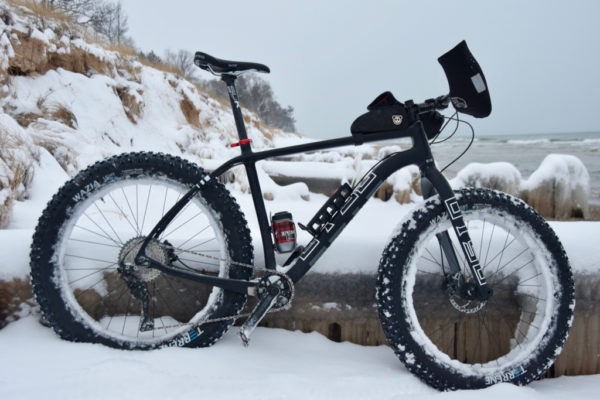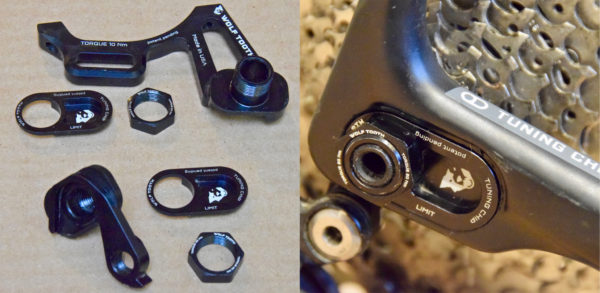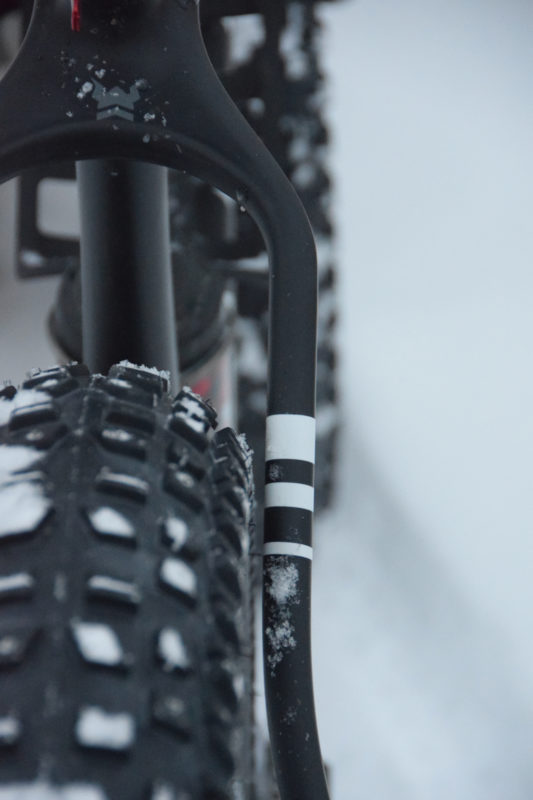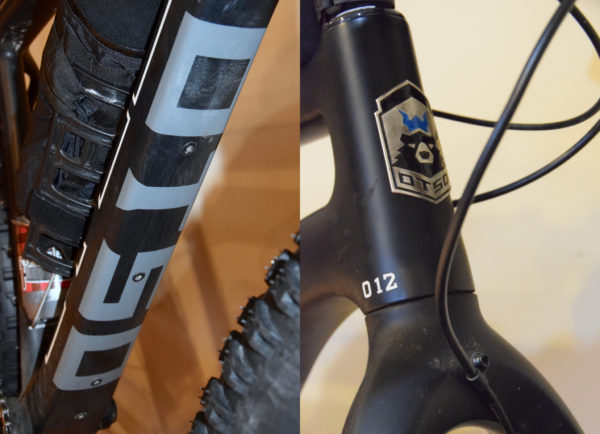
It is kind of funny, last year/season we saw a flood of similar “me-to” fat bikes from manufacturers trying to jump on the fat bike bandwagon. Everyone seemed to want to pile on the fat bike craze. From those heady times, we have seen some really interesting and fresh bikes emerge for the 2017 season. One of the most notable of these “fat” bikes (kinda, more on that in a bit) to emerge this year is the Otso Voytek. Otso is a creation of the Enginerds at Wolf Tooth Components who have been making chainrings, cassette adapters and a whole lot of other high quality parts for bikes. There are so many fresh ideas introduced in the Otso it kind of makes one’s brain hurt but at the same time there is a very specific (but versatile) and singular vision that drives the design of the Otso. This vision revolves around the notion that many of us have figured out; fat bike make pretty bad ass four season bikes. Luckily those enginerds at Wolf Tooth took that idea and ran with it, minimizing some of the negatives of the four season fat bike. In the process they have made one of the better performing fat bikes available regardless of the season you ride it in (if its benefits and negatives align with your riding).
Before we can go any further we need to discuss one of the biggest reasons some people may not want to use a fat bike for all four season; the wider Q-factor of fat bikes. Biomechanically a wide q-factor can cause knee issues and the wider stance may also be less efficient for some riders. For all riders, the wider stance decreases your pedal clearance, constraining how low you can make your bottom bracket before pedal strikes become an issue. The lower you can make your bottom bracket, the more stable a bike feels. Long/short, you want to have your pedalling stance as narrow as possible for your physique.
Otso/Wolf Tooth took a narrow Q-factor fat bike concept that a few custom builders were using, and stretched that concept about as far as it can go. This concept revolves around (pun intended) using the equivalent of an 83mm width bottom bracket shell instead of the normal 100mm bottom bracket that you see on almost every other fat bike. That automatically recoups 17mm from the standard 200-230mm Q-factor range that most fat bikes have (road bikes are normally 150ish mm and 175ish mm for an MTB). Dropping 17mm doesn’t make it as narrow as a “normal” MTB but closes the gap considerably.
Why doesn’t every fat bike have a more narrow Q-factor like the Otso? Because of chainline and tire clearance. You need to push the chainring far to the outside of the bike to allow the chain to work properly with a 170/177mm rear hub spacing (and even further out if your bike has 190/197mm spacing). Normal MTB cranks/chainrings don’t allow the chain to be far enough outboard to clear the tire when using the equivalent of an 83mm BB shell. Luckily, Wolf Tooth components were the perfect people to fix this issue because they make chainrings. Wolf Tooth utilizes a chainring with a ton of offset putting the chainring in the normal place for a fat bike while allowing the crankarms to be 17mm narrower than normal.
Hopefully you the reader have made it this far into the bike dork-fest/minefield of Q-factor and chainline info. The bottomline is that the Voytek has a much more narrow stance/Q-factor than any production fatbike previously offered.

Plenty of clearance with the biggest tires it will fit
The Voytek isn’t a one trick geometry pony though, and offers several other benefits to fat bikers. The biggie is the unique way that the Otso changes the chainstay length on the frame. Moving the rear wheel around in the frame isn’t something that is exactly revolutionary; bikes have been using track dropouts, sliding dropouts or rocker dropouts for years. So why is the Otso unique? The big difference is that most frame designs only move the rear wheel back and forth, the Voytek also moves the rear up/down as you slide it back and forth. All this talk of positions, up/down and in/out may sound like a porn film review but it does something that titillates a bike geek; raising and lowering the bottom bracket when you change the position to fit bigger or smaller diameter wheels.

The Voytek uses a “Tuning Chip” rear dropout system. This isn’t anything new but the fact that its travel isn’t oriented horizontal, parallel to the ground is. Otso angled the Tuning Chip so when you put on a bigger wheel and you need to position the wheel further back in the frame, it also increases the bottom bracket drop and compensates for the taller wheel. Some rocker dropouts do this too but I don’t know of any company making the net drop in BB height as large over the range of rear wheel as Otso with 4mm of total range for BB drop adjustment. It is also worth mentioning the intricate machining and design of the dropouts. Somehow they seem to strike a balance between having every ounce of material machined off while still feeling sufficiently burly. It is also nice to see the laser etching details including the torque specs listed for all of the bolts. The system is simple and easy to use allowing you to quickly change the position of the dropouts in a matter of minutes without any head scratching wondering where parts are supposed to go. The only tools you need are a 20mm socket and a 5mm allen wrench. They have stayed absolutely silent so far with not a creak or pop to be heard.
Depending on where the tuning chip is oriented you have a range from 17.1″ chainstay length in its shortest setting to 17.9″ in longest setting. Otso claims the 17.1″ setting is the “shortest in the world for a fat tire capable bike” which as far as I can tell is true for widely available production fat bikes (Rocky Mountain Suzi Q is equal in length from what I can tell). In the shortest setting the Voytek’s chainstay length is as short as (or shorter than) most modern 29er hardtails so one again, this speaks to the four season optimization.

Clearance is sufficient with 4.6″ tires on the stock 70mm rims but there isn’t any extra room side-to-side
The big limitation imposed on this bike by the narrow stance of the crankset is a limitation on how large of tires you can fit on the bike. The picture above is of a 4.6″ Terrene Wazia mounted on the stock 70mm rims. That combo measures out at a true 4.25″ wide from knob to knob (casing is a bit more narrow). There isn’t a ton of clearance at the seat stays and if your tire/rim is wobbly, you may run into tire/chain rub in the biggest cog.

There are a host of braze-ons which was really nice to see. On the underside of the downtube there is a place for a third waterbottle cage as well as two additional braze-ons for what I can only guess is a fender mount. The fork has a braze-on front and rear in the centerpull brake position. The front facing bolt is used for cable management for the front brake line but having the bolt locations front and rear is nice for mounting a fender on the fork. There are also braze-ons on the underside of the top tube which I am guessing would work well for securing a frame bag.
Geometry is fairly “normal.” It has a 69 degree head tube angle and the fork has 51mm of rake producing around 86mm of trail. This is a nice neutral amount of trail that avoiding extremes in stability (closer to 100mm of trail) or really quick handling (<80mm). The seat tube angle is 73 degrees, and the stack and reach numbers are more on the lower and more stretched out end of the continuum of carbon fat bike frames on the market. The full geometry chart is available here along with a really handy chart for what size tires and wheels fit on the bike. I am shaped a bit funny and needed a longer stem to get my position dialed in but most people should be able to find a size that fits them well. On the trail the bike is composed and well mannered. I have gotten some time on dirt, snow and ice and it has never felt overly twitchy nor like a slug (more on ride impressions in a future post).

Curvy!!! Lots of heel clearance.
If you haven’t already gathered this, there was a lot of thought that went into the frame design as a whole and the carbon construction seems to be similarly well thought out. The seat stays are thin and arched while the chainstays are somewhat flattened to aid compliance/comfort. Both stays are contoured to maximize heal clearance and are just wide enough to provide sufficient clearance for cranks, chainring and tire. The downtube is massive, using almost the entire width of the bottom bracket and when you mash on the pedals the bike feels very responsive and stiff. The top tube is flattened and I have noticed no waggle or flex negatively affecting the cornering of the bike. The fork is one of the nicest carbon fat bike forks I have ever ridden, striking the perfect balance between stiffness for improved handling but still being comfortable. Wisely they included a steel plate to ward off any chainsuck induced frame damage and also a drainage hole in the bottom of the bottom bracket. The rear brake line runs externally (in kind of a weirdly conspicuous location on the downtube) while the rear derailleur runs internally through the top tube and externally down the seat stay making bike maintenance a lot easier than full internal setups. There is nice subtle internal routing for a dropper post.

I have used the bike in the stock 26 fat arrangement (both 4″ and 4.6″ tires) as well as with 650B+ wheels and 29+ wheels. Personally, I found the 650B+ wheels to be a stretch due to the bottom bracket being so low (I measured 11.8″). That could be remedied a bit by putting on a suspension fork that would raise the front end a bit (and the BB too) but then you are also slacking the angles of the frame which may or may not be desireable. With the stock fork and the B+ wheels I was getting a ton of pedal strikes. With 29+ wheels and the Tuning Chip in the furthest back position the bike rode wonderfully. Ditto for 26×4″ tires with the Tuning Chip in the forward position and 26x 4.6″ tires with the Tuning Chip in the rearward position. Everything on this bike just seems to be very sorted and works exactly as they claim (and the rider would hope) that it will.
My first impressions of the Voytek are very, very positive. Not only have they designed in some features that should offer big advantages for some riders (like the narrow Q-factor) but they have also developed a very well thought out design with high quality construction. I have already ridden it more than enough to highly recommend it if the narrow Q-factor is an important factor for you and it should be on just about any rider’s short list if you are looking for a carbon fat bike that will run plus wheels also. The big limitation is its inability to run fat tires over 4.3″ in actual width. I am going to continue to put this bike through its paces over the coming months and will provide some updates on how it handles and holds up in future write-ups.

Thanks for sharing Ken, I learn something new with every review you put out. I have seen the Voytek at my LBS here in Anchorage, AK. One of the shop employees just recently purchased the Voytek and she is loving it. She’s a shorty and appreciates the narrower Q. I asked her about the tire size limitations, she said she always rides 4″ tires as she’s short and light. I’ve been riding Dillinger 4’s lately and having major issues in softer conditions. In fact I’m putting my Dillinger 5’s back on tonight. Seems to me that if you live in a place that gets decent snow you would want the ability to squeeze in the bigger tires. Look forward to your full shakedown. I heard rumor that a Voytek in disguise ran the ITI last year. Will be interesting to see if it shows up this year.
@thub — you can run Dillinger 5s on the Voytek with stock rims as they are a 4.6″ casing. We have been running D5’s, Wazzia 5.6 and Dunderbiest tires extensively this winter and they work great. The first prototype Voytek did run the ITI (and Arrowhead 135) last year ridden by Dan, one of my business partners here at Otso.
Really great review Ken — love that you explained all the tech details that we spent so much time developing. I can also confirm those extra mounting points on the downtube are for a fender (the PDW one works great).
Mike
@Mike – Thanks for the information. I’m riding Nextie 90mm rims that I am keen to stay on. Do you think I could run Dilly 5’s on 90mm rims and still clear? I had the pleasure of meeting Dan last winter here in Anchorage at the Expo. Dan hooked me up with a flask, it works great! I have a Wolf Tooth 30t Drop Stop chain ring on my bike, haven’t dropped a chain yet and I don’t use a guide. Big fan of Wolf Tooth. If I am not mistaken The Bicycle Shop in Anchorage has a Otso available for demo. I’m going to have to give it a whirl.
thub — those tires would not clear on 90mm rims. The widest rims you can use and still clear the rear on a Voytek would be something like our stock rims or a Whiskey 70mm.
Feel free to email us directly if you have more questions. sales@otsocycles.com
Otso did an excellent job with the Voytek. The bike handles awesome on the trails, its fast and responsive. The bike takes the best parts of fat bikes (traction and float) and leaves behind the worst (large Q and sluggish handling). Snow riding is a very small % of my riding, so huge tires on super wide rims aren’t my prime need. Vanhelgas on 65mm handle any snow I will see just fine. 4″ tires on a 24lb, narrow Q fat bike with short CS, it really doesn’t get any better than that.
Awesome mtb!!